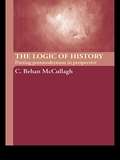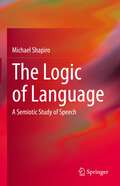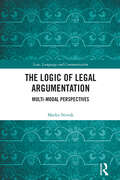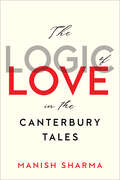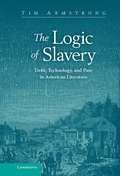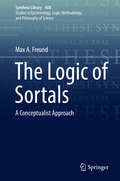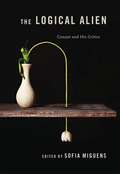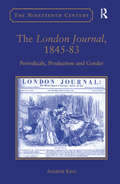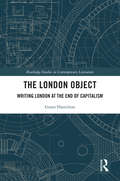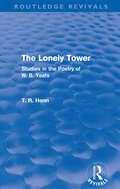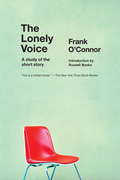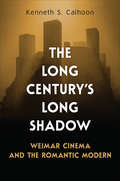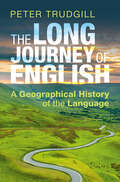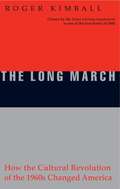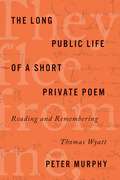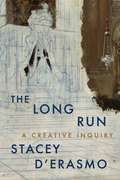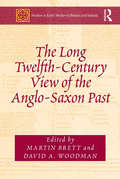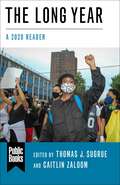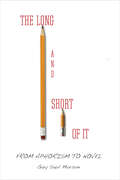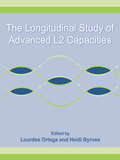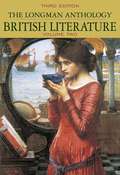- Table View
- List View
The Logic of Connective Action
by W. Lance Bennett Alexandra SegerbergThe Logic of Connective Action explains the rise of a personalized digitally networked politics in which diverse individuals address the common problems of our times such as economic fairness and climate change. Rich case studies from the United States, United Kingdom, and Germany illustrate a theoretical framework for understanding how large-scale connective action is coordinated using inclusive discourses such as "We Are the 99%" that travel easily through social media. In many of these mobilizations, communication operates as an organizational process that may replace or supplement familiar forms of collective action based on organizational resource mobilization, leadership, and collective action framing. In some cases, connective action emerges from crowds that shun leaders, as when Occupy protesters created media networks to channel resources and create loose ties among dispersed physical groups. In other cases, conventional political organizations deploy personalized communication logics to enable large-scale engagement with a variety of political causes. The Logic of Connective Action shows how power is organized in communication-based networks, and what political outcomes may result.
The Logic of History: Putting Postmodernism in Perspective
by C. Behan McCullaghThe Logic of History reveals the rational basis for historians' descriptions, interpretations and explanations of past events. C. Behan McCullagh defends the practice of history as more reliable than has recently been acknowledged. Historians, he argues, make their accounts of the past as fair as they can and avoid misleading their readers. He explains and discusses postmodern criticisms of history, providing students and teachers of history with a renewed validation of their practice. McCullagh takes the history debate to a new stage with bold replies to the major questions historians face today.
The Logic of Language: A Semiotic Study of Speech
by Michael ShapiroThis book serves as a basis for the exploration of language in a more systematic way. By surveying the several major divisions of language (phonology, morphology, syntax, lexis, tropology) and explicating the way in which sound and meaning cohere in them, this text lays bare––for students, scholars and advanced readers alike––the lineaments of an understanding of what makes language the sign system par excellence, in the service of its most important function as the instrument of cognition and of communication. This book is intended as a companion volume to Shapiro’s The Speaking Self: Language Lore and English Usage. The two volumes taken in tandem will provide a solid grounding in the observational science of linguistics, linking theory with practice in a way that will expand one’s understanding of language as a global phenomenon.
The Logic of Legal Argumentation: Multi-Modal Perspectives (Law, Language and Communication)
by Marko NovakMulti-modal argumentation with its logical, emotional, visceral and kisceral arguments is an important addition to logical argumentation, especially when real-life situations are considered. It does not discard logic but adds other modes of argumentation to complement it, to emphasize the realistic environments of communication. In this sense, the multi-modal theory is important for the area of legal argumentation, where even in the reasoning of judicial decisions traces of a flesh-and-blood personality, who decided the case and wrote the reasons, can be found. This book presents a comprehensive analysis of this informal logic in legal argumentation and its practicality within the law. It argues that by building on the dialectical and rhetorical models of legal argument, the former being important for clear cases while the latter for unclear ones, the multi-modal theory of legal argumentation brings together logic and psychology in a holistic or integral perspective. The approach is not only descriptive, identifying the traces of alternate arguments in judicial decisions, but is also normative, presenting the criteria for evaluation that multi-modal arguments need to face to attain validity in the legal context. The work will be of interest to academics and researchers in the areas of Legal Theory, Legal Linguistics, Philosophy of Law, and Communication Studies.
The Logic of Love in the Canterbury Tales
by Manish SharmaThe Logic of Love in The Canterbury Tales argues that Geoffrey Chaucer’s magnum opus draws inventively on the resources of late medieval logic to conceive of love as an "insoluble." Philosophers of the fourteenth century expended great effort to solve insolubilia, like the notorious Liar paradox, in order to decide upon their truth or falsity. For Chaucer, however, and in keeping with Christ’s admonition from the Sermon on the Mount, the lover does not judge – does not decide on – the beloved. Through a series of detailed and rigorously "non-judgmental" readings, Manish Sharma provides new insight into each of the prologues and tales and intervenes into scholarly debates about their collective import. In so doing, The Logic of Love in The Canterbury Tales deploys Chaucer’s understanding of charity to consider the limitations of modern critical approaches to The Canterbury Tales, including deconstruction, psychoanalysis, and gender theory. In the course of the analysis, Sharma shows not only how love and medieval philosophy together inform Chaucerian composition, but also how Chaucer could serve as a resource for contemporary theoretical reflections on love and ethics.
The Logic of Slavery: Debt, Technology, and Pain in American Literature
by Tim ArmstrongIn American history and throughout the Western world, the subjugation perpetuated by slavery has created a unique 'culture of slavery'. That culture exists as a metaphorical, artistic and literary tradition attached to the enslaved - human beings whose lives are 'owed' to another, who are used as instruments by another and who must endure suffering in silence. Tim Armstrong explores the metaphorical legacy of slavery in American culture by investigating debt, technology and pain in African-American literature and a range of other writings and artworks. Armstrong's careful analysis reveals how notions of the slave as a debtor lie hidden in our accounts of the commodified self and how writers like Nathaniel Hawthorne, Rebecca Harding Davis, Booker T. Washington, W. E. B. Du Bois, Ralph Ellison and Toni Morrison grapple with the pervasive view that slaves are akin to machines.
The Logic of Sortals: A Conceptualist Approach (Synthese Library #408)
by Max A. FreundSortal concepts are at the center of certain logical discussions and have played a significant role in solutions to particular problems in philosophy. Apart from logic and philosophy, the study of sortal concepts has found its place in specific fields of psychology, such as the theory of infant cognitive development and the theory of human perception. In this monograph, different formal logics for sortal concepts and sortal-related logical notions (such as sortal identity and first-order sortal quantification) are characterized. Most of these logics are intensional in nature and possess, in addition, a bidimensional character. That is, they simultaneously represent two different logical dimensions. In most cases, the dimensions are those of time and natural necessity, and, in other cases, those of time and epistemic necessity. Another feature of the logics in question concerns second-order quantification over sortal concepts, a logical notion that is also represented in the logics. Some of the logics adopt a constant domain interpretation, others a varying domain interpretation of such quantification. Two of the above bidimensional logics are philosophically grounded on predication sortalism, that is, on the philosophical view that predication necessarily requires sortal concepts. Another bidimensional logic constitutes a logic for complex sortal predicates. These three sorts of logics are among the important novelties of this work since logics with similar features have not been developed up to now, and they might be instrumental for the solution of philosophically significant problems regarding sortal predicates. The book assumes a modern variant of conceptualism as a philosophical background. For this reason, the approach to sortal predicates is in terms of sortal concepts. Concepts, in general, are here understood as intersubjective realizable cognitive capacities. The proper features of sortal concepts are determined by an analysis of the main features of sortal predicates. Posterior to this analysis, the sortal-related logical notions represented in the above logics are discussed. There is also a discussion on the extent to which the set-theoretic formal semantic systems of the book capture different aspects of the conceptualist approach to sortals. These different semantic frameworks are also related to realist and nominalist approaches to sortal predicates, and possible modifications to them are considered that might represent those alternative approaches.
The Logic of Wish and Fear: New Perspectives on Genres of Western Fiction
by Ben La FargeMoving effortlessly from Greek to Shakespearean tragedies, to nineteenth and twentieth-century British, American and Russian drama, and fiction and contemporary television, this study sheds new light on the art of comedy.
The Logical Alien: Conant And His Critics
by Sofia MiguensIs our logical form of thought merely one among many, or must it be the form of thought as such? From Kant to Wittgenstein, philosophers have wrestled with variants of this question. This volume brings together nine distinguished thinkers on the subject, including James Conant, author of the seminal paper “The Search for Logically Alien Thought.”
The London Journal, 1845-83: Periodicals, Production and Gender (The Nineteenth Century Series)
by Andrew KingThis book is the first full-length study of one of the most widely read publications of nineteenth-century Britain, the London Journal, over a period when mass-market reading in a modern sense was born. Treating the magazine as a case study, the book maps the Victorian mass-market periodical in general and provides both new bibliographical and theoretical knowledge of this area. Andrew King argues the necessity for an interdisciplinary vision that recognises that periodicals are commodities that occupy specific but constantly unstable places in a dynamic cultural field. He elaborates the sociological work of Pierre Bourdieu to suggest a model of cultural 'zones' where complex issues of power are negotiated through both conscious and unconscious strategies of legitimation and assumption by consumers and producers. He also critically engages with cultural theory as well as traditional scholarship in history, art history, and literature, combining a political economic approach to the commodity with an aesthetic appreciation of the commodity as fetish. Previous commentators have coded the mass market as somehow always 'feminine', and King offers a genealogy of how such a gender identity came about. Fundamentally, however, the author relies on new and extensive primary research to ground the changing ways in which the reading public became consumers of literary commodities on a scale never before seen. Finally, King recontextualizes within the Victorian mass market three key novels of the time - Walter Scott's Ivanhoe (serialised in the London Journal 1859-60), Mary Braddon's Lady Audley's Secret (1863), and a previously unknown version of Émile Zola's The Ladies' Paradise (1883) - and in so doing he lends them radically new and unexpected meanings.
The London Object: Writing London at the End of Capitalism (Routledge Studies in Contemporary Literature)
by Grant HamiltonÉtienne Balibar writes that today we are at the end of capitalism. This is not because capitalism has run its course or has met an irresistible force, but because there can be no purer form of capitalism than the one we have today. Taking seriously the idea that this strain of capitalism has not only seized the urban environment but is the urban environment, works by Michael Moorcock, Iain Sinclair, Penelope Lively, Peter Ackroyd, and J.G. Ballard are read as representative of a loosely allied group of London writers who have anticipated, critiqued, and offered up various avenues of resistance to the deleterious effects of this most vigorous strain of capitalism. Writing on the city by charting a politics of reconnection to the real that necessarily unsettles the epistemological and ontological ground upon which both modernity and capitalism sit, this stable of writers makes clear the ways in which the sheer materiality of the urban environment profoundly influences the being and thinking of individuals. In so doing, these writers produce works which when read together give the coordinates of an altermodernity that might just allow capitalism to reach its final conclusion.
The Lonely Tower: Studies in the Poetry of W. B. Yeats (Routledge Revivals)
by Thomas Rice HennFirst published in 1965, this reissue of the second edition of T. R. Henn’s seminal study offers an impressive breadth and depth of meditations on the poetry of W. B. Yeats. His life and influences are discussed at length, from the impact of the Irish Rebellion upon his youth, to his training as a painter, to the influence of folklore, occultism and Indian philosophy on his work. Henn seeks out the many elements of Yeats’ famously complex personality, as well as analysing the dominant symbols of his work, and their ramifications.
The Lonely Voice
by Frank O'ConnorThe legendary book about writing by the legendary writer is back! Frank O'Connor was one of the twentieth century's greatest short story writers, and one of Ireland's greatest authors ever. Now, O'Connor's influential and sought-after book on the short story is back. THE LONELY VOICE offers a master class with the master. With his sharp wit and straightforward prose, O'Connor not only discusses the techniques and challenges of a form in which "a whole lifetime must be crowded into a few minutes," but he also delves into a passionate consideration of his favorite writers and their greatest works, including Chekhov, Hemingway, Kipling, Joyce, and others.
The Long Century’s Long Shadow: Weimar Cinema and the Romantic Modern (German and European Studies)
by Kenneth S. CalhoonThe Long Century’s Long Shadow approaches German Romanticism and Weimar cinema as continuous developments, enlisting both in a narrative of reciprocal illumination. The author investigates different moments and media as connected phenomena, situated at alternate ends of the "long nineteenth century" but joined by their mutual rejection of the neo-classical aesthetic standard of placid and weightless poise in numerous media, including film, painting, sculpture, prose, poetry, and dance. Connecting Weimar filmmaking to Romantic thought and practice, Kenneth S. Calhoon offers a non-technological, aesthetic genealogy of cinema. He focuses on well-known literary and artistic works, including films such as Nosferatu, Metropolis, Frankenstein, and Fantasia; the writings of Conrad, Kafka, Goethe, and Novalis; and the paintings of Caspar David Friedrich, one of the leading artists of German Romanticism. With an eye to the modernism of which Weimar filmmaking was a part, The Long Century’s Long Shadow employs the Romantic landscape in poetry and painting as a mirror in which to regard cinema.
The Long Journey of English: A Geographical History of the Language
by Peter TrudgillEnglish is one of the most widely-spoken languages in the world, with native-speaking communities at the furthest ends of the earth. However, just three thousand years ago, the language-which-became-English was not spoken anywhere in Britain. Trudgill, one of the foremost authorities on the English language, takes us on a remarkable journey through the history of English to show how it grew to become the global phenomenon that we know today. Over ten short, easily digestible chapters, he traces its development and global spread, starting with the earliest genesis of English five thousand years ago, exploring its expansion in the British Isles, and finishing with an overview of how the language looks today, including its use in an increasingly digital world. Particular attention is paid to the native-speaker varieties of English from all around the world, and the relationship between colonial varieties of English and indigenous languages.
The Long March
by Roger KimballIn The Long March, Roger Kimball, the author of Tenured Radicals, shows how the "cultural revolution" of the 1960s and '70s took hold in America, lodging in our hearts and minds, and affecting our innermost assumptions about what counts as the good life. Kimball believes that the counterculture transformed high culture as well as our everyday life in terms of attitudes toward self and country, sex and drugs, and manners and morality. Believing that this dramatic change "cannot be understood apart from the seductive personalities who articulated its goals," he intersperses his argument with incisive portraits of the life and thought of Allen Ginsberg, Norman Mailer, Timothy Leary, Susan Sontag, Eldridge Cleaver and other "cultural revolutionaries" who made their mark. For all that has been written about the counterculture, until now there has not been a chronicle of how this revolutionary movement succeeded and how its ideas helped provoke today's "culture wars." The Long March fills this gap with a compelling and well-informed narrative that is sure to provoke discussion and debate.
The Long Public Life of a Short Private Poem: Reading and Remembering Thomas Wyatt (Square One: First-Order Questions in the Humanities)
by Peter MurphyThomas Wyatt didn't publish "They Flee from Me." It was written in a notebook, maybe abroad, maybe even in prison. Today it is in every poetry anthology. How did it survive? That is the story Peter Murphy tells—in vivid and compelling detail—of the accidents of fate that kept a great poem alive across 500 turbulent years. Wyatt's poem becomes an occasion to ask and answer numerous questions about literature, culture, and history. Itself about the passage of time, it allows us to consider why anyone would write such a thing in the first place, and why anyone would care to read or remember the person who wrote it. From the deadly, fascinating circles of Henry VIII's court to the contemporary classroom, The Long Public Life of a Short Private Poem also introduces us to a series of worlds. We meet antiquaries, editors, publishers, anthologizers, and critics whose own life stories beckon. And we learn how the poem came to be considered, after many centuries of neglect, a model of the "best" English has to offer and an ideal object of literary study. The result is an exploration of literature in the fine grain of the everyday and its needs: in the classroom, in society, and in the life of nations.
The Long Run: A Creative Inquiry
by Stacey D'ErasmoThe author of The Art of Intimacy asks eight legendary artists: What has sustained you in the long run?How do we keep doing this—making art? Stacey D’Erasmo had been writing for twenty years and had published three novels when she asked herself this question. She was past the rush of her first books and wondering what to expect—how to stay alive in her vocation—in the decades ahead.She began to interview older artists she admired to find out how they’d done it. She talked to Valda Setterfield about her sixty-year career that took her from the Merce Cunningham Dance Company to theatrical collaborations with her husband to roles in films. She talked to Samuel R. Delany about his vast oeuvre of books in many genres. She talked to Amy Sillman about working between painting and other media and between abstraction and figuration. She talked to landscape architect Darrel Morrison, composer Tania Léon, actress Blair Brown, and musician Steve Earle, and started to see connections between them and to artists across time: Colette, David Bowie, Ruth Asawa. She found insights in own experience, about what has driven and thwarted and shaped her as a writer.Instead of easy answers or a road map, The Long Run offers one practitioner’s conversations, anecdotes, confidences, and observations about sustaining a creative life. Along the way, it radically redefines artistic success, shifting the focus from novelty and output and external recognition toward freedom, fluidity, resistance, community, and survival.
The Long Space
by Peter HitchcockThe resurgence of "world literature" as a category of study seems to coincide with what we understand as globalization, but how does postcolonial writing fit into this picture? Beyond the content of this novel or that, what elements of postcolonial fiction might challenge the assumption that its main aim is to circulate native information globally?The Long Spaceprovides a fresh look at the importance of postcolonial writing by examining how it articulates history and place both in contentandform. Not only does it offer a new theoretical model for understanding decolonization's impact on duration in writing, but through a series of case studies of Guyanese, Somali, Indonesian, and Algerian writers, it urges a more protracted engagement with time and space in postcolonial narrative. Although each writer-Wilson Harris, Nuruddin Farah, Pramoedya Ananta Toer, and Assia Djebar-explores a unique understanding of postcoloniality, each also makes a more general assertion about the difference of time and space in decolonization. Taken together, they herald a transnationalism beyond the contaminated coordinates of globalization as currently construed.
The Long Twelfth-Century View of the Anglo-Saxon Past (Studies in Early Medieval Britain and Ireland)
by Martin Brett David A. WoodmanScholars have long been interested in the extent to which the Anglo-Saxon past can be understood using material written, and produced, in the twelfth century; and simultaneously in the continued importance (or otherwise) of the Anglo-Saxon past in the generations following the Norman Conquest of England. In order to better understand these issues, this volume provides a series of essays that moves scholarship forward in two significant ways. Firstly, it scrutinises how the Anglo-Saxon past continued to be reused and recycled throughout the longue durée of the twelfth century, as opposed to the early decades that are usually covered. Secondly, by bringing together scholars who are experts in various different scholarly disciplines, the volume deals with a much broader range of historical, linguistic, legal, artistic, palaeographical and cultic evidence than has hitherto been the case. Divided into four main parts: The Anglo-Saxon Saints; Anglo-Saxon England in the Narrative of Britain; Anglo-Saxon Law and Charter; and Art-history and the French Vernacular, it scrutinises the majority of different genres of source material that are vital in any study of early medieval British history. In so doing the resultant volume will become a standard reference point for students and scholars alike interested in the ways in which the Anglo-Saxon past continued to be of importance and interest throughout the twelfth century.
The Long Year: A 2020 Reader (Public Books Series)
by Eric Klinenberg Joan Wallach Scott Julie Livingston Natalia Molina Jun Li Guobin Yang Andrew Lakoff Priscilla Wald Warwick Anderson Warren Breckman Adam Tooze Ananya Roy Sophie Lewis Neha Vora Margaret O'Mara Yarimar Bonilla Merlin Chowkwanyun Keeanga-Yamahtta Taylor Margaret Morganroth Gullette Marcia Chatelain Jacob A.C. Remes Joanne Randa Nucho Xiaowei Wang Miguel Centeno Jean-Paul Gagnon Keisha N. Blain Sulfikar Amir Mustafa Dikeç David Schmidt Gautam Bhan David S. Barnes Isabelle Guérin Andy Horowitz Simon Balto Éric Charmes Max Rousseau Michelle Cera Gilles Guiheux Ye Guo Renyou Hou Manon Laurent Anne-Valérie Ruinet Govindan Venkatasubramanian Mathieu Ferry Marine Al Dahdah Sherihan Radi Jeffrey Aaron Snyder Rachel Nolan Evan Lieberman Julia Foulkes Soledad Álvarez Velasco Sophie Gonick Alfonso Fierro Erick Corrêa Gianpaolo Biaocchi Jake Carlson Quentin Ravelli Rikki J. Dean Afsoun Afsahi Emily Beausoleil Selen A. Ercan Cordula Dittmer Daniel F. Lorenz Kathryn Cai Kavita SivaramakrishnanSome years—1789, 1929, 1989—change the world suddenly. Or do they? In 2020, a pandemic converged with an economic collapse, inequalities exploded, and institutions weakened. Yet these crises sprang not from new risks but from known dangers. The world—like many patients—met 2020 with a host of preexisting conditions, which together tilted the odds toward disaster. Perhaps 2020 wasn’t the year the world changed; perhaps it was simply the moment the world finally understood its deadly diagnosis.In The Long Year, some of the world’s most incisive thinkers excavate 2020’s buried crises, revealing how they must be confronted in order to achieve a more equal future. Keeanga-Yamahtta Taylor calls for the defunding of police and the refunding of communities; Keisha Blain demonstrates why the battle against racism must be global; and Adam Tooze reveals that COVID-19 hit hardest where inequality was already greatest and welfare states weakest. Yarimar Bonilla, Xiaowei Wang, Simon Balto, Marcia Chatelain, Gautam Bhan, Ananya Roy, and others offer insights from the factory farms of China to the elite resorts of France, the meatpacking plants of the Midwest to the overcrowded hospitals of India.The definitive guide to these ongoing catastrophes, The Long Year shows that only by exposing the roots and ramifications of 2020 can another such breakdown be prevented. It is made possible through institutional partnerships with Public Books and the Social Science Research Council.
The Long and Short of It: From Aphorism to Novel
by Gary MorsonBrevity may be the soul of wit, but it is also much more. In this exploration of the shortest literary works—wise sayings, proverbs, witticisms, sardonic observations about human nature, pithy evocations of mystery, terse statements regarding ultimate questions—Gary Saul Morson argues passionately for the importance of these short genres not only to scholars but also to general readers. We are fascinated by how brief works evoke a powerful sense of life in a few words, which is why we browse quotation anthologies and love to repeat our favorites. Arguing that all short genres are short in their own way, Morson explores the unique form of brevity that each of them develops. Apothegms (Heraclitus, Lao Tzu, Wittgenstein) describe the universe as ultimately unknowable, offering not answers but ever deeper questions. Dicta (Spinoza, Marx, Freud) create the sense that unsolvable enigmas have at last been resolved. Sayings from sages and sacred texts assure us that goodness is rewarded, while sardonic maxims (Ecclesiastes, Nietzsche, George Eliot) uncover the self-deceptions behind such comforting illusions. Just as witticisms display the power of mind, "witlessisms" (William Spooner, Dan Quayle, the persona assumed by Mark Twain) astonish with their spectacular stupidity. Nothing seems further from these short works than novels and epics, but the shortest genres often set the tone for longer ones, which, in turn, contain brilliant examples of short forms. Morson shows that short genres contribute important insights into the history of literature and philosophical thought. Once we grasp the role of aphorisms in Herodotus, Samuel Johnson, Dostoevsky, and even Tolstoy, we see their masterpieces in an entirely new light.
The Long-legged Horse
by Wendell BerryFirst published in 1969 and out of print for more than 25 years, this was Berry's first collection of essays, the inaugural work introducing many of the central issues that have occupied him over the course of his career.
The Longitudinal Study of Advanced L2 Capacities (Second Language Acquisition Research Series)
by Lourdes Ortega Heidi ByrnesResearchers and educators routinely call for longitudinal research on language learning and teaching. The present volume explores the connection between longitudinal study and advanced language capacities, two under-researched areas, and proposes an agenda for future research. Five chapters probe theoretical and methodological reflections about the longitudinal study of advanced L2 capacities, followed by eight chapters that report on empirical longitudinal investigations spanning descriptive, quasi-experimental, qualitative, and quantitative longitudinal methodologies. In addition, the co-editors offer a detailed introduction to the volume and a coda chapter in which they explore what it would take to design systematic research programs for the longitudinal investigation of advanced L2 capacities. The scholars in this volume collectively make the argument that second language acquisition research will be the richer, theoretically and empirically, if a trajectory toward advancedness is part of its conceptualization right from the beginning and, in reverse, that advancedness is a particularly interesting acquisitional level at which to probe contemporary theories associated with the longitudinal study of language development. Acknowledging that advancedness is increasingly important in our multicultural societies and globalized world, the central question explored in the present collection is: How does learning over time evolve toward advanced capacities in a second language?
The Longman Anthology of British Literature: The Romantics and Their Contemporaries (Volume 2A)
by David Damrosch Kevin J. H. DettmarResponding to major shifts in literary studies, this was the first collection to pay attention to the contexts within which literature is produced, even as it broadened the scope of that literature to embrace the full diversity of the British Isles.

